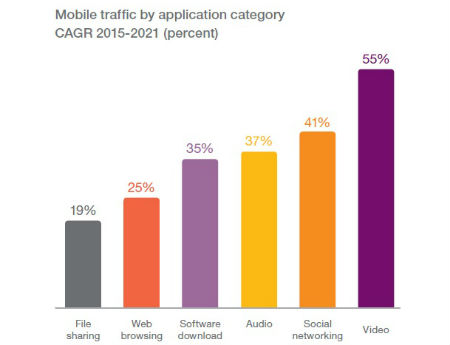Mobile Video Traffic to Keep Surging: Ericsson

Social networking will continue to eat up a sizable chunk of mobile data traffic, but video will remain the category's dominant application for the foreseeable future, according to Ericsson’s latest Mobility Report.
Ericsson predicts that mobile video traffic will grow by about 55% annually through 2021, when it should account for more than two-thirds of all mobile data traffic. By 2020 , video will account for around 70% of mobile data traffic, the report found.
Social networking will grow by 41% in the next six years, but its relative share of traffic will drop from 15% in 2015, to about 10% in 2021, thanks to video’s continued growth.
“The trend is accentuated by the growing use of embedded video in social media and web pages, which is considered video traffic in this context,” Ericsson noted in the report.
Ericsson said YouTube will dominate video traffic on most mobile networks, accounting for 50% to 70% of total video traffic. In markets where Netflix has launched services (it’s been expanding globally), its share of video traffic is poised to reach 10% to 20% of total mobile video traffic.
Among other key findings, Ericsson said the Internet of Things will overtake mobile phones as the largest category of connected devices by 2018. Looking further ahead, Ericsson said 17 billion of the 28 billion total devices that will be connected by 2021 will be IoT devices.
That growth, Ericsson said, will be principally be driven by regulatory requirements, such as smart utility meters, coupled with growing demand for connected cars.
The smarter way to stay on top of the multichannel video marketplace. Sign up below.
“From 2020, commercial deployment of 5G networks will provide additional capabilities that are critical for IoT, such as network slicing and the capacity to connect exponentially more devices than is possible today,” Rima Qureshi, SVP and chief strategy officer at Ericsson, said in a statement.
Per the report, global mobile subscriptions are growing at about 3% per year, and reached 7.4 billion in Q1 2016. India (21 million) saw the most growth in terms of net additions, followed by Myanmar (+5 million), Indonesia (+5 million), the U.S. (+3 million) and Pakistan (+3 million).
Mobile broadband subscriptions, meanwhile are growing by around 20% per year, rising by roughly 40 million in Q1 2016 alone. Total LTE subscriptions currently stand at around 1.2 billion, Ericsson said.
